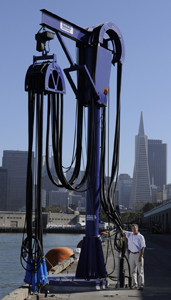When a dead whale arrived draped over the bow of a container vessel calling the Port of Oakland last month, some environmentalists cited the ship’s high velocity as the cause.

This new cruise-ship-to-shoreside electrical power connection will help to reduce emissions from ships docking at the Port of San Francisco. Photo courtesy of the Port of San Francisco
By Patrick Burnson
Published: October, 2010
With prospects still murky for the global economy, many container lines are setting out on a clear course for fuel-efficient slow steaming. And it’s here to stay, said spokesmen for Maersk Line, a major carrier serving Bay Area shippers. Spokesmen for the Danish company said that its service has also become more reliable as a consequence, citing the following statistics:
• A ship that reduces speed by 20 percent will use 40 percent less fuel, thereby reducing carbon dioxide emissions correspondingly. To maintain the same service frequency and compensate for a lower average speed, 1-2 extra vessels are added per route, or string. Despite the extra vessels, slow steaming has reduced Maersk Line’s carbon dioxide emissions by about 7 percent per container moved.
• Schedule reliability improves because slow speed allows vessels to continuously adjust speed in order to deliver the cargo exactly on time. Maersk Line has a goal of 95 percent schedule reliability and is, according to analysts, already well on the way to achieving its goal. From April to June 2010, Maersk Line had a 77 percent on-time performance score with the closest competitors ranging from 59 percent to 64 percent.
• The concept of slow steaming was originally a hard sell to engine manufacturers. It took off in 2007 and was instrumental for Maersk Line to cut carbon emissions per container by 12.5 percent from 2007 to 2009. The goal is to reduce emissions by 25 percent in 2020.
S.F. Port to Inaugurate Shoreside Power for Cruise Ships
While the Port of San Francisco remains a minor player in the world of containerized shipping, it is growing its cruise business by leaps and bounds. Further evidence of this will be presented at the ceremony commemorating the inaugural connection of cruise ship to shoreside electrical power at Pier 27 this month.
San Francisco Mayor Gavin Newsom will be on hand, as well as representatives from the port and Princess Cruises, to usher in the new resource on Wednesday, October 6.
The event has plenty of “green” backers, too, including the Bay Area Air Quality Management District; San Francisco Public Utilities Commission; and the U.S. Environmental Protection Agency.
Peterson Address Tech Trends for Shippers
Among those analysts addressing current trends in technology at last month’s Oracle Open World in San Francisco was Beth Peterson of Beth Peterson Enterprises, a consulting firm for global multi-national shippers and transportation providers specializing in global trade management and supply chain planning.
Peterson managed Hewlett Packard’s U.S. import operations and also worked for DHL Airways, Inc. where she was a logistics services manager. She has over 20 years experience in the logistics and international transportation business.
Peterson is also chairwoman of the Northern California chapter of Women in International Trade (WIT), a great networking resource for anyone engaged in importing and/or exporting. She offers additional domain expertise as a licensed customs broker. And you can learn more about WIT by visiting www.wit-nc.com.

